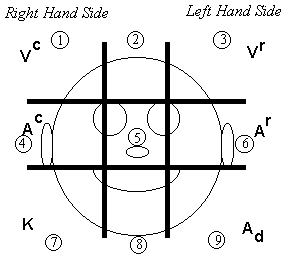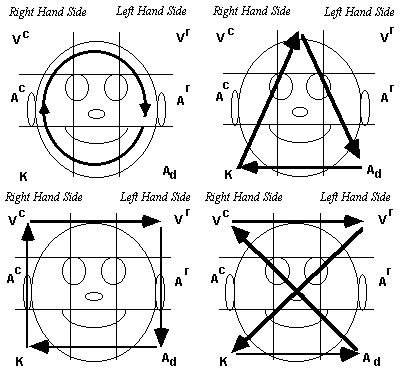
From the NLP point of view, eye scanning patterns_the movement of the eyes from one position to another_reflect connections and overlaps (synesthesias), and also discontinuities, between different representational system functions; and thus between different states, parts, personalities, neural structures, etc. If you ask a person to move his or her eyes "very slowly" from one basic eye position (i.e., up-left, down-right, up-right, lateral-left, etc.) to another, you will observe that movement is seldom perfectly smooth and linear. The ease or difficulty a person has in making such a motion is indicative of which cognitive and representational processes are habitually more connected or separated for that person.
Creativity, flexibility and learning involve the ability to think in new and different ways. One approach to developing new abilities is to find habitual ways of thinking and then change or add to them. One way to find and break habitual ways of thinking using NLP is through eye movement patterns. Since our eyes reflect patterns of our internal processes they may be used as a tool for both diagnosing and changing habitual thought patterns.
The following exercises were developed by Robert Dilts in 1986 in order to utilize eye scanning patterns as a means to explore your habitual thinking patterns, and then to expand and enrich them.
"Eye Skating": Exercises For The "Mind's Eyes"As an exercise, try the following experiment. Keeping your head oriented straight in front of you, put your eyes into each of the basic eye positions indicated on the eye movement chart. Hold each eye position for 30 seconds. Have a partner keep track of the time for you so you are not distracted.

Notice the differences you experience between each position. Are some of them more comfortable, natural or familiar feeling than some of the others? Does it feel to you as if you are actually holding your eyes for a longer time in some of the positions than others? In some of the positions you might find yourself thinking or making certain types of associations. In others, you may just draw a complete blank. Which eye positions do you associate more with creativity? stuckness? being a dreamer? being a realist? being a critic?
Exercise 2: Exploring the Effects of Eye Position on Problem SolvingAs a further experiment, take some problem or idea you are working on and simply hold your eyes in these different positions for a few minutes while you are thinking of it. Notice how it effects your thought process in relation to the problem or idea. How has the way in which you are thinking about the idea or problem changed as a result of each eye position? Be especially aware of how you are affected by the unfamiliar eye positions. Do any of the eye positions bring out certain kinds of feelings, sounds or imagery? Does moving your eyes to any of these locations change any of the qualities of the images, sounds or feelings you already have associated to the problem or idea?
Exercise 3: Exploring Patterns of Eye Movement and SynesthesiasOur physiology, and in particular our eye movements, form the underlying circuitry through which our strategies are manifested. Thus, our strategies are only as effective as the neuro-physiological circuitry which supports them. Much creative thinking comes from our ability to link our sensory representational systems together - as in a synesthesia. Patterns of eye movements also reflect which senses we tend to habitually link together and how strong those links are.
As another exercise, try moving your eyes between various combinations of the different eye positions; say, from up left to down right and back again, or from up right to up left and back again (if you use all 9 positions, there are about 45 possible combinations). Some of the most common and significant patterns are shown below.
Move your eyes back and forth between the two eye positions you have chosen about 6 times. Start by moving your eyes very slowly at first and then speed up the movement. Try to move your eyes between the two positions in a straight, smoothly line. Then switch to another pair of eye positions and repeat the process again. Keep choosing new pairs until you have covered all of the basic pairs of eye positions.
Find a partner to act as an observer. Have your observer notice exactly how your eyes move between the two positions. You will probably soon realize that movement is seldom perfectly linear. Often the eyes will move in little jerks, pausing briefly in certain places along the path of trajectory. Often the eyes will arc rather than move in a straight line from one location to the other. Sometimes the eyes will move farther in one direction than the other.
Patterns of eye movements are a way of linking various parts of your neurology together by laying down a physiological track or path between the various parts of your brain that you use to represent information about the world around you. The ease or difficulty you have in moving your eyes to these different positions can help you to assess which neurological pathways are most open and smooth. In fact, we sometimes use this particular procedure to make what is called an "eye print" of an individual. Like a finger print, a person's "eye print" is a representation about an individual's unique characteristics - but on a neurological instead of physical level. Eye prints can help you to get insight into which parts of a person's brain are habitually connected or separated, and thus what kinds of thinking processes a person might excel at or have difficulty with. This in turn can help assess what kinds of aptitudes, inner conflicts or personality traits a person might be most likely to experience and express. It can also be used as a way to define areas that may be improved and enhanced.
As in the previous exercise on eye position, take note of which patterns of movement seem most comfortable, familiar and natural. Do some patterns seem more related or conducive to certain types of thinking? Once again notice which patterns of movement seem more connected with creativity? stuckness? being a dreamer? being a realist? being a critic?
Exercise 4. Creating and Strengthening New Neurological PathwaysTake the patterns of movement which seemed the most difficult, awkward or uncomfortable and "beat a path" between the to eye positions by moving your eyes back and forth between the positions. Your partner can help you by using his or her finger as a guide for your eyes. Have your partner hold a finger about a foot to a foot and a half in front of you and move the finger back and forth between the two eye positions you want to link together more strongly. Your partner should begin by moving the finger very slowly at first in a smooth, even, linear path. As your eyes accommodate to the movement, ask your partner to increase the speed of the finger motion, tracing the same path. You may do this without a partner by drawing a line on a piece of paper and use it as a guide by holding it in front of you at the proper angle.
To assess the impact of creating these new links, once again take some problem or idea you are working on and notice how using each new circuit effects it. First take note of how you are thinking about the problem or idea. Is it primarily feelings, words, sound, or images? What qualities or submodalities seem to be emphasized in your current representation of the problem or idea? Then, without consciously focusing on the idea or problem, have your partner (or the paper guide line) lead you through the new eye pattern. Notice how it effects your thought process in relation to the problem or idea. How does the way in which you are thinking about the idea or problem change as a result of the new pattern? What changes in terms of the qualities of the images, sounds or feelings you had initially associated to the problem or idea?
Exercise 5. Exploring and Creating New Circuits Through Eye Movement PatternsClearly, more sophisticated thinking patterns tend to require more sophisticated patterns of eye movements. If you begin to observe people, you probably notice that a person's eyes can move in some fairly involved sequences. Some patterns appear to be almost circular; others may be triangular, rectangular or some other type or combination of shapes (some examples are shown below).

As an experiment, try tracing some of these basic kinds of shapes with your eyes. Make a circle, a square, a triangle or some other shape. Make sure you repeat the pattern a few times to get a sense for how it effects you. How easy or comfortable is it to move your eyes in that pattern?
Now try changing some aspect of the eye movement pattern. If you traced the circle in one direction, reverse it. If the base of the triangle was on the bottom, turn it upside down. What effect does that have on you or your state of consciousness?
As with the previous eye exercises, take some problem or idea you are working on and notice how using a new pattern of circuitry effects it. Once again, note the cognitive structure of how you initially think about the problem or idea. What aspects of imagery, sound and/or feeling seem to be emphasized in your starting representation of the problem or idea? Again, go through the new eye pattern without consciously focusing on the idea or problem, and notice how it effects your thought process in relation to the problem or idea. How does the way in which you are thinking about the idea or problem change as a result of the new pattern? What changes in terms of the qualities of the images, sounds or feelings you had initially associated to the problem or idea?
In NLP, these types of eye movement combinations are used in a more precise way to develop new thinking strategies - such as in the New Behavior Generator strategy.
Sometimes habitual synesthesia patterns can cause problems as well, and may need to be interrupted. The Failure Into Feedback strategy, in fact, explicitly addresses the relationship between eye position and synesthesia patterns. The process, which involves breaking and reestablishing synesthesia patterns through the use of eye movements, is described in detail in Changing Belief Systems with NLP (1990, pp. 25-53).
The process of EMDR (Eye Movement Desensitization Response), developed by Francine Shapiro, draws from this type of use of eye movements.
For information on Robert Dilts’ products and services, please see Upcoming Seminars or Robert’s Product Page or return to Home Page. If you have problems or comments concerning our WWW service, please send e-mail to the following address: michaelp@bowsprit.com.
This page, and all contents, are Copyright © 1998 by Robert Dilts., Santa Cruz, CA.